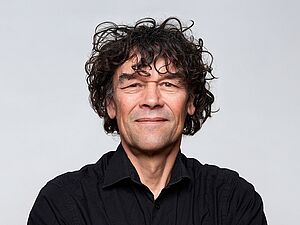"It brings me joy and pays off financially"
Voices on biodiversity
Thomas Baumann runs the "Galegge" farm and is committed to nature and environmental protection on the municipal council of Suhr. (Photo: made available)
A newly created pond serves to breed carp and promote biodiversity at the same time. Fish farming generates a higher contribution margin than arable land and provides a safe home for the endangered noble crayfish. (Photo: FiBL, Franziska Hämmerli)
Thomas Baumann has fenced off a strip of land for pigs along a meandering stream in favour of rectangular farmland. The pigs dig up the soil, providing the natterjack toad with a new home. (Photo: FiBL, Franziska Hämmerli)
Thomas Baumann runs the "Galegge" in Suhr in the canton of Aargau, a leased organic farm covering 39 hectares. The ETH agronomist is not only committed to nature and environmental protection on the farm, but also on the municipal council of Suhr. He also works as a project manager for promoting nature at the Naturama in Aarau. He has been involved in the implementation of the Labiola programme, which has been promoting biodiversity in Aargau since 1991, from the very beginning.
As a farmer, what do you do to promote biodiversity?
Biodiversity is one of the four branches of our farm. It is also an economically successful branch, as the accountant recently assured me again. However, this is only possible because I manage the biodiversity areas rationally and with appropriate effort in order to achieve the desired biodiversity goals. It is important to achieve quality level II for the biodiversity areas because of the federal subsidies.
What does that look like in concrete terms?
Most of our meadows on hills are biodiversity areas. As I have a small livestock population in relation to the land area, I sell the first cut as hay for horses and then use the nourishing aftermath as feed for the dairy goats. Where arable farming is possible, I grow food on around 80 per cent of the land. All of the unshaped crop rotation areas are used as biodiversity areas. This means that the intensively used arable areas are nice and rectangular and I can do my work efficiently. I need fewer turning manoeuvres, less time and diesel, and have around 15 to 20 percent valuable biodiversity areas in the arable land.
Why are you doing this?
Because it brings me joy and because it pays off financially. I receive a lot of praise, goodwill and validation from the local population, who also values our land as a local recreational area.
How can we stir the public's interest in biodiversity?
By making it a tangible experience. When walking in my area, you can hear the natterjack toads calling, the crickets chirping and the yellowhammers singing. You can lie down in the shade of a hedge and watch the kestrels hovering.
Every area used for biodiversity is thus not available for food production. What is your take on this?
We don't have a problem with lack of area at all. Today, 70 percent of the land in Switzerland is used for meat production. Even if a large proportion of this is permanent grassland, that's still a lot. If arable farming were more in line with the food pyramid, two things would happen: We would increase the proportion of domestic food production and more land would be freed up for biodiversity.
Do you see agriculture as an important aspect for strengthening biodiversity?
Yes, but forestry and settlement areas such as industrial parks, neighbourhoods with single-family homes or public areas are just as important.
How are you committed to biodiversity as a local councillor in Suhr?
All farms in Suhr were successfully encouraged to take part in the Labiola programme, which has been promoting biodiversity in Aargau for over 30 years. In public spaces of residential areas, we were able to unseal areas, plant trees and create areas with ruderal vegetation. The municipal building commission provides advice to building contractors. This usually improves the quality of outdoor spaces with additional biodiversity.
And what are you doing for the forest area?
There is little I can achieve there. The forest in Suhr belongs to the local people and they have their own idea of what makes a "forest". A large part of the population wrongly assumes that forest equals high-quality nature, but this is not the case. We have an intensive timber industry on often drained areas. In the forest area, much more would be possible in terms of biodiversity with sparse forests, wetlands, silvopasture or areas of old wood.
Not all organic farmers are in favour of the biodiversity initiative, which will be put to a vote in Switzerland on 22 September. Why is that?
I realise that, for a long time, little attention was paid to biodiversity in organic farming. In the development of organic farming, the emphasis was placed on a cropping system free from synthetic chemical inputs. It was believed that biodiversity would automatically do well on an organic farm. However, this is not the case: with improved management and increased yields in organic farming, many animal and plant species such as skylarks, cornflowers and natterjack toads have disappeared from organic fields. Awareness is lagging behind the actual development. This could be the reason why organic farmers consider the biodiversity initiative to be unnecessary.
I have heard that many farmers are afraid to stand up for biodiversity for fear of defamation. Is that true?
Yes, I hear that time and time again.
Interview: Franziska Hämmerli, FiBL
Further information
Links
- galegge.org: Website of the "Galegge" farm (in German)
- ag.ch: Labiola programme (in German)






